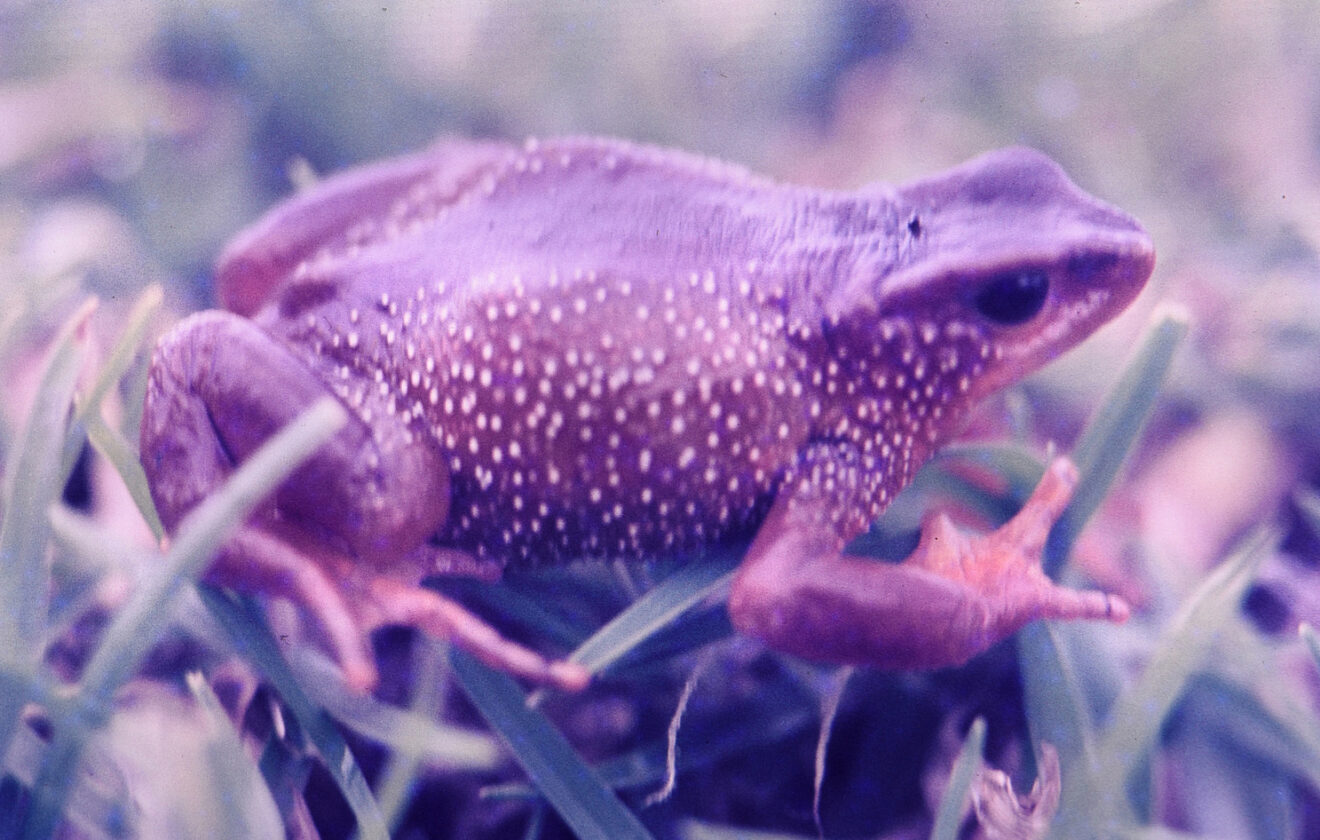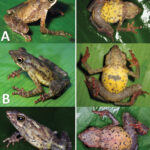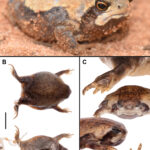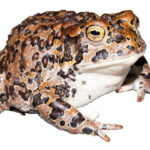- Introduction: An Amphibian Gem of the Andes
- Taxonomy and Classification: Decoding the Identity of <em>Atelopus guanujo</em>
- Natural Habitat: Amidst the Misty Highlands of Ecuador
- Physical Characteristics: A Display of Nature’s Artistry
- Behavior and Life Cycle: Moonlit Serenades Along the Streamside
- Ecological Role: The Fragile Guardian of Biodiversity
- Threats and Conservation Status: Rallying for a Vanishing Treasure
- Cultural and Scientific Significance: A Species that Inspires and Teaches
- Conclusion: Preserving a Jewel in Nature’s Crown
Introduction: An Amphibian Gem of the Andes#
Hidden among the verdant forests and chilling mountain streams of Ecuador’s breathtaking Andes, there dances a jewel-like amphibian cloaked in vibrant hues—the Guanujo stubfoot toad (Atelopus guanujo). Yet this resplendent creature is much more than a captivating display of nature’s artistry; it forms a critical component of its fragile ecosystem. It is also facing intense threats from habitat loss, climate crisis, and devastating amphibian diseases, pushing it precariously closer toward extinction.
Fascinating in appearance and delicate in ecological importance, the species is highly prized among conservationists, researchers, and nature enthusiasts alike. Few sights in nature can rival the vibrant spectacle of a male Guanujo stubfoot toad calling gently from his mossy empire beside a bubbling mountain stream—a haunting reminder of nature’s delicate beauty and the urgent responsibility we bear for its protection.
Taxonomy and Classification: Decoding the Identity of Atelopus guanujo#
Scientifically known as Atelopus guanujo, the Guanujo stubfoot toad belongs to the family Bufonidae, famously known as true toads. Don’t let the “toad” moniker deceive you, however; the colorful genus Atelopus comprises slender, vividly ornamented amphibia that defy traditional expectations of toad morphology. Within this genus, over a hundred unique and compelling species have been documented, many facing perilously declining populations.
Atelopus guanujo shares close evolutionary ties with species such as Atelopus carbonerensis and Atelopus ignescens, and together these “stubfoot” amphibians form a distinct lineage adapted specifically to the cool, moist environments of South America’s highland forests. Named after the Guanujo locality—an area high in the cloud forests of Ecuador—the species is an emblematic representative of the region’s unique biodiversity.
Natural Habitat: Amidst the Misty Highlands of Ecuador#
Perched high in the lofty mountains of central Ecuador lies a habitat remarkably special and delicate—the cloud forests and Andean moorlands known locally as páramos. These mist-shrouded ecosystems, nourished abundantly by rainfall and humidity, form the home of Atelopus guanujo. The species primarily inhabits montane forests, closely tied to unspoiled freshwater streams cascading down the lush mountainsides.
Unlike frogs that dwell high among branches or hidden beneath leaves, Atelopus guanujo lives predominantly on or near the forest floor, seeking refuge within moss-covered rocks, shaded foliage, and gently flowing streams. Here, the air holds the chill bite of altitude, tempered by the ceaseless murmurs of crystal-clear waters—ideal conditions for moisture-dependent amphibians.
The Importance of Pristine Streams#
Water plays an undeniable central role in the lives of Guanujo stubfoot toads. They rely on pristine, oxygenated streams for reproduction and maintaining a moisture-rich environment essential to their survival. The presence of these toads often signifies high water quality, making them invaluable indicators of ecosystem health. As human encroachment disturbs their habitats, any negative impact on water quality can swiftly and tragically impact these fragile populations.
Physical Characteristics: A Display of Nature’s Artistry#
Atelopus guanujo sports striking colorations that seem almost too vibrantly fantastic to exist in reality. Typically, the species showcases an intricate palette of bright yellows, deep oranges, and contrasting black or dark-brown markings, creating a pattern designed by evolution to warn potential predators of its mild toxic defenses. Averaging between three to four centimeters in length, these frogs can comfortably rest within the cup of a single leaf—tiny living masterpieces of biodiversity.
Adding to their elegance, Guanujo stubfoot toads exhibit slim, graceful limbs and finely sculpted bodies. Their digits, characterized by shortened ‘stubbed’ appearance, give rise to their common name. These unusual digits do more than pique human curiosity; they assist the frogs in securely traversing moss-covered rocks and streambeds, perfectly suited for their slippery and damp habitat.
Adaptations for Survival#
Guanujo stubfoot toads possess critical survival adaptations, such as vivid aposematic coloration that warns predators of their toxic skin secretions. Indeed, their striking colors—which immediately attract the human eye—serve as a warning, discouraging birds, reptiles, and small mammals from predation. However, while their mild toxicity shielding them from many predators, it provides them no defense against the challenges posed by human-led ecological changes and disease.
Behavior and Life Cycle: Moonlit Serenades Along the Streamside#
Quiet evenings in the habitat of Atelopus guanujo are often punctuated by subtle, melodic calls from males looking to attract females. Male stubfoot toads establish territories along pristine stream banks, defending small zones of mossy rocks and submerged branches. Throughout the breeding season, they audibly announce their presence and readiness, transforming quiet nights into gentle serenades carrying softly through the forest air.
Courtship and Reproduction#
Once a female is drawn to a calling male, she carefully assesses both partner and nesting territory, eventually choosing the most suitable location promising safety and resource abundance. Mating occurs via amplexus, the male embracing the female to fertilize her eggs as she deposits them directly into the water, ensuring ideal oxygenation and protection amid the currents. Egg masses, delicately secured under rocks or vegetation, release tadpoles after some days, which then continue their complex aquatic transformations into adults over weeks or months.
Parental care is largely absent in this species; survival relies upon strategic breeding locations and the inherent richness of their pristine aquatic environment. Yet, witnessing these tiny tadpoles gracefully navigating mountain streams beneath the watchful canopy stands as a remarkable testament to nature’s astounding adaptability and beauty.
Ecological Role: The Fragile Guardian of Biodiversity#
As both predator and prey, the Guanujo stubfoot toad occupies a critical ecological niche. They primarily consume small invertebrates such as insects, spiders, and tiny worms, controlling their populations naturally. Conversely, as prey, these toads contribute vital nutrition to various forest residents that can tolerate their toxins. Furthermore, as indicators, their presence signifies balanced, intact habitats, making their decline a stark warning of broader environmental disruption.
Threats and Conservation Status: Rallying for a Vanishing Treasure#
Today, the Guanujo stubfoot toad stands alarmingly listed as Critically Endangered on the International Union for Conservation of Nature (IUCN) Red List. Throughout the past three decades, their numbers have plummeted profoundly due primarily to habitat loss, climate change effects, and the inexorable spread of chytridiomycosis—an infectious fungal disease causing drastic amphibian declines worldwide.
Conservation Efforts in Ecuador#
Fortunately, researchers, local communities, and conservation organizations have united passionately. Ongoing initiatives include habitat protection through designation of key conservation areas, efforts at captive breeding, and close monitoring of surviving populations. For concerned conservationists, each surviving individual represents precious hope — the possibility of ensuring the continuity of this remarkable species and safeguarding the unique biodiversity they epitomize.
Cultural and Scientific Significance: A Species that Inspires and Teaches#
Native Ecuadorian cultures hold frogs and toads in deep respect, viewing them as symbols of fertility, abundance, and especially essential indicators of ecological health. Scientifically, every remaining population of Atelopus guanujo provides incredible insights into high-altitude amphibian ecology, adaptation, and evolving responses to human-induced change. Each frog offers science critical information, emphasizing the importance of protecting even the smallest ecosystem members.
Conclusion: Preserving a Jewel in Nature’s Crown#
To observe a Guanujo stubfoot toad crouched quietly on its emerald perch is to catch sight of a rare, vulnerable jewel threatened by our modern challenges. As we now share awareness of their story, we gain a profound responsibility—not just to protect Atelopus guanujo, but the rich web of life they represent. I invite you—join conservation efforts, raise your voice, and help us ensure that future generations might also marvel at these tiny ambassadors from Ecuador’s misty Andean mountains.











